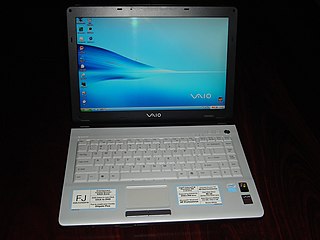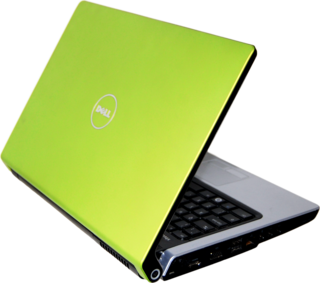External links
- Sony Vaio VPCY11S1E VAIO Series Y (in Italian)
| Desktops | |||||
|---|---|---|---|---|---|
| Notebooks | |||||
| Ultraportables |
| ||||
The Vaio Y series is a line of notebook computer from Sony introduced in January 2010. It is a netbook-inspired model designed for travel use: compared with the other 13.3" models in the Vaio range, the Y lacks an optical drive, and is heavier and cheaper than the premium Sony Vaio Z series, but lighter than the consumer-grade Sony Vaio S series, with better battery life than either, thanks to the use of CULV processors. The weight is 3.92lbs (1.78kg).
The Y series features a 13.3" 16:9 1366x768 screen, 2-8GB of DDR3 RAM, hard drive or SSD, CULV Intel dual-core CPU, Mobile Intel Intel GMA 4500MHD or ATI Mobility Radeon HD 4550 graphics (refreshed models only), integrated VGA webcam, gigabit ethernet, 802.11b/g/n wireless, and Windows 7 64 bit. Initially the Y series shipped with a Core 2 CULV CPUs; the mid-2010 refresh saw these replaced with newer Arrandale CULV chips.
Battery specs are 5000 mAh (330g - standard) or 7500 mAh (490g - extended).
Dell XPS is a line of high performance computers manufactured by Dell.

The Sony Vaio FJ series is a 14.1 inch notebook designed for Windows XP and the FJ270, FJ290, FJ330,FJ370 models in particular, are designed for Windows Vista. The FJ Series uses only the Pentium M processors using the Sonoma platform of Intel Centrino.

Dell Vostro is a line of business-oriented computers from Dell aimed at small businesses. In 2013, the line was discontinued on some Dell websites but continued to be offered in other markets, such as Malaysia.

Dell's Studio brand was a range of laptops and desktops targeted at the mainstream consumer market. The computers sit above Dell's Inspiron and below the XPS consumer lines in price and specifications. They differ from Dell's lower-end Inspiron models by offering slot-loading optical drives, media keys, more cover design options, faster processor options, HDMI and eSATA ports, LED-backlit screens and backlit keyboards.

HP TouchSmart is a series of tablet PC laptops and touchscreen all-in-one desktop computers designed by HP. It features various Intel or AMD processors and runs Windows Vista or Windows 7 as standard.

The Sony Vaio P series is a range of ultraportable subnotebook computers launched in January 2009.
Sony has used the Z model naming scheme for its high-end ultraportable notebook computers since 2000. Unlike other Sony models, the Z has always been manufactured in Japan or in the United States for some models. Sony has stated that production of the Z series will cease at the end of 2012.
The Sony Vaio SR series was a line of consumer-grade notebook computers from Sony introduced in July/August 2008 to replace the Sony Vaio C series range, as a part of the Intel Centrino 2 launch. They are equipped with a 13.3" screen and weigh approximately 1.95kg, significantly lighter than the C series, similar to the non-premium carbon fiber models of the SZ, but significantly heavier than the Z Series.

The Vaio S series was a line of notebook computers from Sony introduced in summer 2004. They have been touted as business laptops, and their designs have focused on being thin and light. They also have features friendly to businesspeople, such as TPM chips, matte (anti-glare) displays, RAID SSDs, and extended sheet batteries, as well as continuing to include RJ-45 and VGA (D-Sub) connections.
The Sony Vaio 505 series was a line of ultraportable notebook computers from Sony's VAIO brand. The introduction date in the United States was July 24, 1998.
Sony VAIO AR series was a range of high-end multimedia notebook computers from Sony introduced in June 2006 as the first laptop with integrated Blu-ray drive. It replaced the AX Series. It featured a 17" 16:10 widescreen LCD screen, with choice of 1440x900 or 1920x1200 resolutions. It was replaced by the AW series.
The Sony Vaio FS series is a discontinued range of laptops sold by Sony. It was launched in January 2005 and featured an Intel Pentium M at 1.6 or 1.73 GHz with 512 MB of RAM and Intel GMA 900 or nVidia Geforce 6200 graphics. The screen was a 15.4" 1280x800 display with an 80 GB or 100 GB 4200 rpm hard drive, DVD playback and CD burner and 802.11b/g wi-fi. It weighed 2.9 kg.
The Sony Vaio G series was a range of ultraportable subnotebook computers launched in 2007 with a 12.1" display.

The first laptop in the IdeaPad U series was the U110 launched in 2008 by Lenovo. Showcased at CES 2008, the laptop also launched the IdeaPad series itself, and received the Best of CES 2008 award. The IdeaPad U series was a line of Lenovo’s consumer line of laptops, combining Lenovo’s traditional engineering with design changes that were significantly different from ThinkPad products.
The IdeaPad Y series is a consumer range of laptops produced by Lenovo, first announced in 2008. They are marketed as premium high performance laptops for multimedia and gaming, as part of the IdeaPad line. The most significant differences from Lenovo's traditional ThinkPad business laptops were a more consumer-oriented appearance and performance-oriented components. IdeaPads feature a chiclet keyboard with rounded keys, similar to the latest ThinkPads. The first of the Y series were the IdeaPad Y710 and the IdeaPad Y510 notebooks, with screen sizes of 17 inches and 15 inches respectively. Not all features were entirely new, however. Notebook Review reported that the Y710 and Y510 notebooks had a keyboard that felt similar to the ThinkPad when used, despite the absence of the TrackPoint. The Y50 and Y40, released in 2014, featured a gaming-oriented design shift and slimming down. The latest release was the Y700 in late 2015.
The A Series desktops are part of Lenovo’s ThinkCentre product line. Formerly an IBM brand, Lenovo acquired the ThinkCentre desktop brand following its purchase of IBM’s Personal Computing Division (PCD) in 2005. The first desktop in the A Series was the ThinkCentre A50p. Lenovo has released A Series desktops in multiple form factors, ranging from traditional tower, to small form factor, and all-in-ones (AIOs).
The M-series of desktops are part of Lenovo's ThinkCentre product line. Formerly an IBM brand, Lenovo acquired the ThinkCentre desktop brand following its purchase of IBM's Personal Computing Division (PCD) in 2005. Following its acquisition of IBM's PCD, Lenovo has released M-series desktops in multiple form factors, ranging from traditional tower, to small form factor, and all-in-ones (AIOs).
The IdeaCentre K Series desktops from Lenovo are described by the manufacturer as being gaming-oriented desktops. Typical features on the desktops include mid-range to high-end processors, discrete graphics cards, multiple hard disk drives, multiple RAM DIMMS, multiple USB ports, and multiple optical disk drives. The K Series desktops also come with a physical switch on the CPU that allows users to shift between different levels of processing power. For example, the K330 offered red for high performance, blue for moderate performance, and green for less processing- and resource-intensive tasks.
In addition to the ThinkPad and IdeaPad laptops, Lenovo also offers a value-priced series of laptops. Called ‘Essential’ on the Lenovo Web site, the products available in this line include the G Series, B Series, and V Series. Launched in 2009, the first laptop in the Essential range was the G530.
The Sony Vaio VGX series was a series of living room PCs created for Sony's Vaio line that were released from 2005 until 2008. The VGX series was aimed at consumers who wanted the flexibility of able to watch TV and have the functionality of a computer at the comfort of their living room. All models came built-in with an HDMI port, VHF/UHF output, S-Video, Optical Audio port, and a variation of Microsoft Windows with Media Center installed.